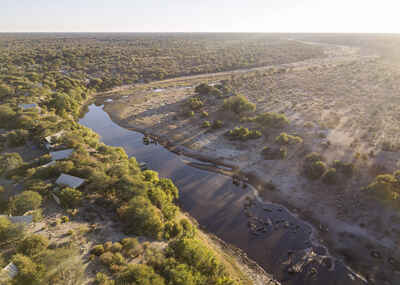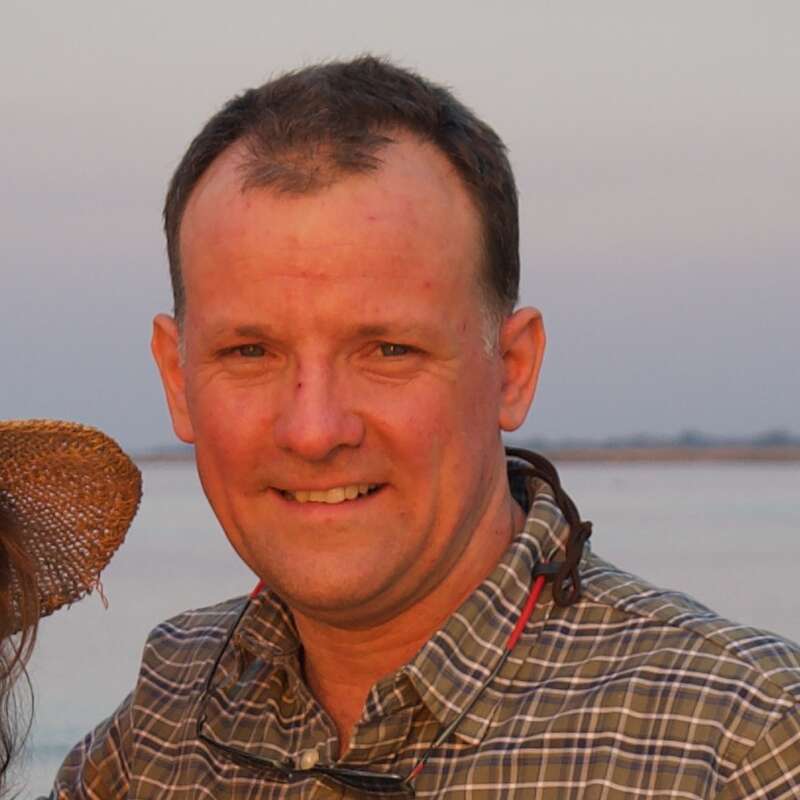About Meno A Kwena
Meno A Kwena is an old-style safari camp; the owners we know well.
It is situated on tribal land on a cliff edge overlooking the Boteti River, which began to flow again in late 2008, having been dry for over 15 years. The name Meno A Kwena is the local name for the area, which translates as 'teeth of the crocodile'.
Meno A Kwena's relaxed atmosphere, warm welcome and the team's keen interest in the surrounding area and its wildlife shine through – as does the hands-on approach of the camp's committed owner and managers. It won't be to everyone's liking – it's fairly rustic, and if you are travelling to Botswana for a pure big-game experience then it's tempting to say Meno A Kwena will not be for you. The return of water to the Boteti has started to change the dynamic here however and often game-viewing from the camp is as good as it is from the vehicle.
Looking at the bigger picture, Meno exists right on the transition zone between the unique Okavango Delta region of the Kalahari and the more typical, dryer regions further south - it's this location which makes it special. So, if you are keen to experience something slightly different from the norm with a rather quirky feel and an emphasis on the human side of life in Botswana as well as the wildlife, Meno is certainly worth a visit for at least a couple of nights.
Our view
Meno A Kwena's relaxed atmosphere, warm welcome and the team's keen interest in the surrounding area and its wildlife shine through – as does the hands-on approach of the camp's committed owner and managers. It won't be to everyone's liking – it's fairly rustic, and if you are travelling to Botswana for a pure big-game experience then it's tempting to say Meno A Kwena will not be for you. The return of water to the Boteti has started to change the dynamic here however and often game-viewing from the camp is as good as it is from the vehicle.
Looking at the bigger picture, Meno exists right on the transition zone between the unique Okavango Delta region of the Kalahari and the more typical, dryer regions further south - it's this location which makes it special. So, if you are keen to experience something slightly different from the norm with a rather quirky feel and an emphasis on the human side of life in Botswana as well as the wildlife, Meno is certainly worth a visit for at least a couple of nights.
Accommodation
9 Safari tents
Children
Best for 12+
Open
All year
Activities

4WD Safari

Birdwatching

Boat trip

Cultural excursion

Guided walking safari

Private activities
Traveller reviews of Meno A Kwena
13 real, un-edited reviews from Expert Africa's travellers.
Arrived 6 Apr 2022, 3 nights
"Meno A Kwena review"
Overall rating: Good
Arrived 12 Jan 2016, 2 nights
"Better than I expected"
Overall rating: Excellent
Arrived 16 Sep 2013, 3 nights
"Lovely camp, river view, and San"
Overall rating: Excellent
Arrived 30 Aug 2013, 3 nights
"great"
Overall rating: Excellent
Arrived 29 Jul 2013, 1 nights
"Meno A Kwena review"
Overall rating: Excellent
Arrived 24 Oct 2010, 3 nights
"Mixed impression at Meno A Kwena"
Overall rating: Good
Arrived 23 Oct 2010, 3 nights
"Meno A Kwena review"
Overall rating: Excellent
Arrived 30 Oct 2008, 3 nights
"Meno A Kwena review"
Overall rating: Good
Arrived 21 Sep 2008, 2 nights
"Superb camp at Meno A Kwena"
Overall rating: Excellent
Arrived 14 Jul 2008, 3 nights
"Laid back, prehaps a little too much."
Overall rating: Average
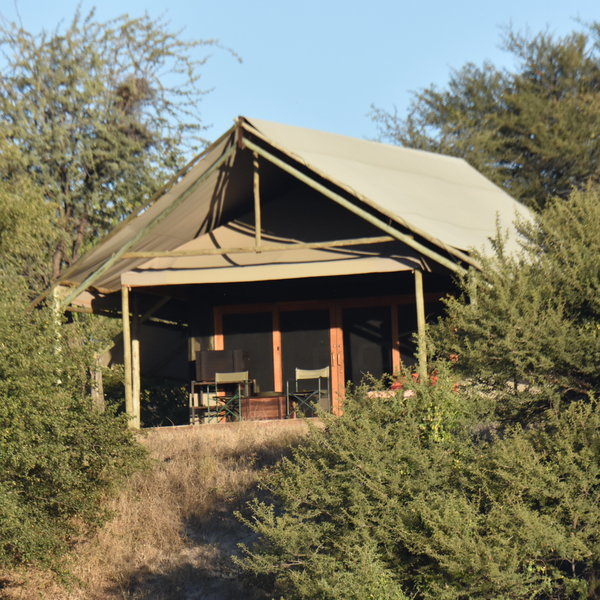
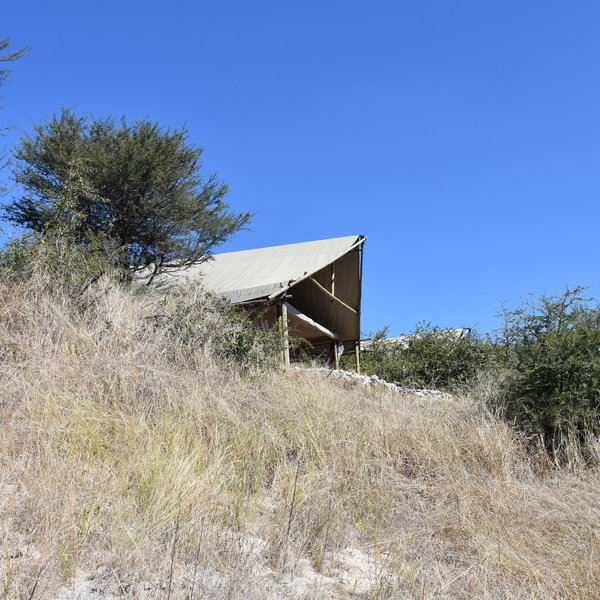
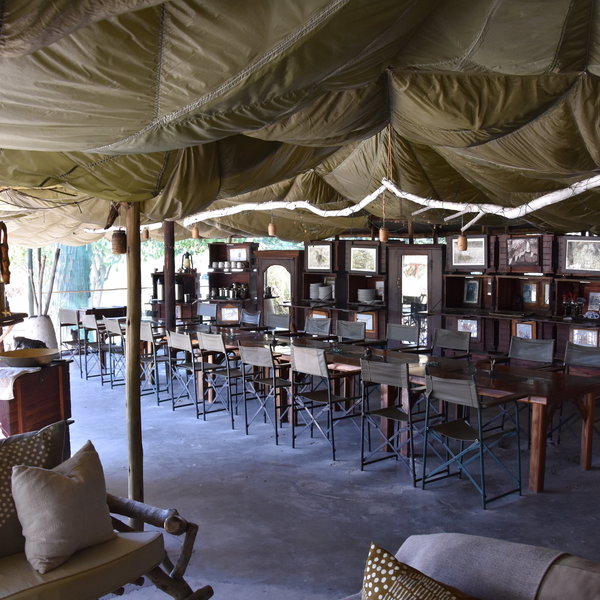
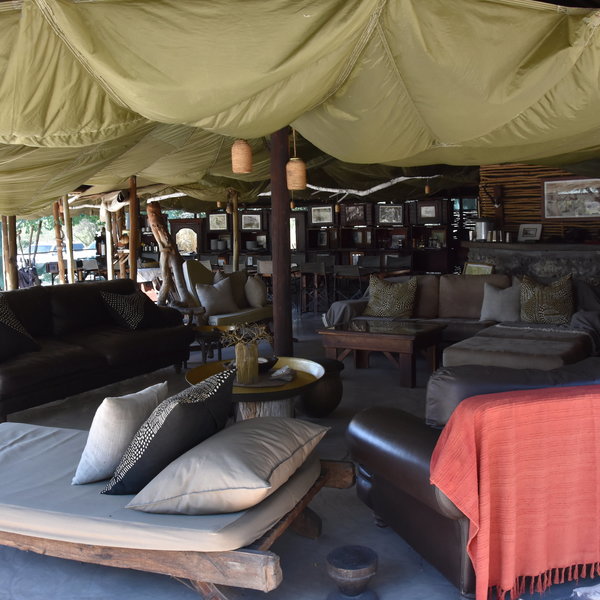
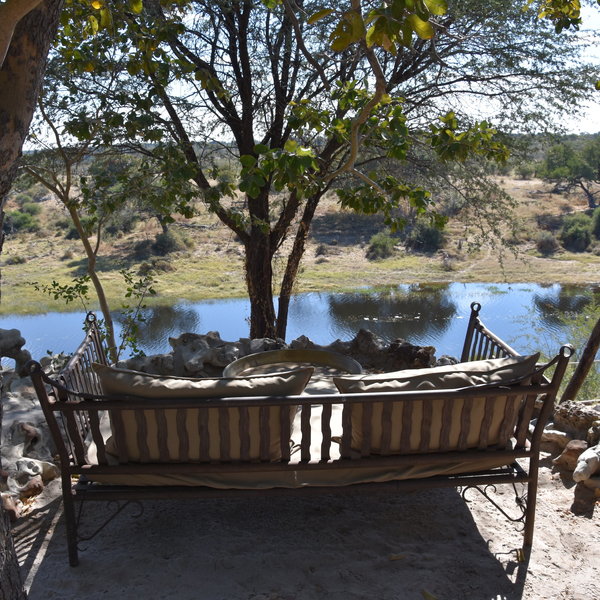
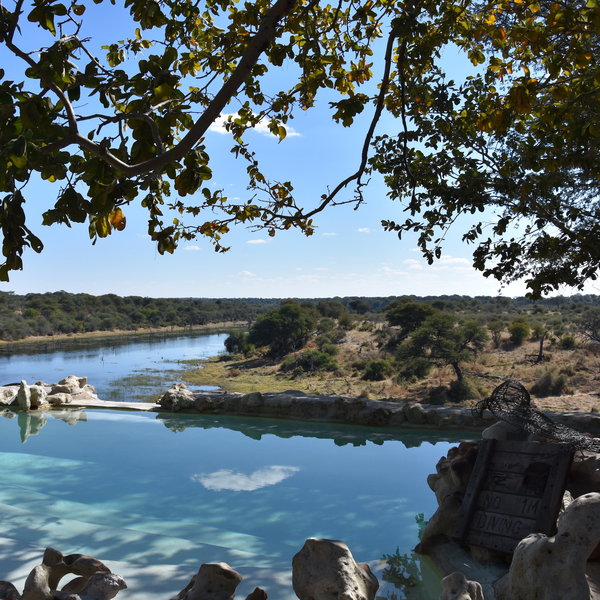
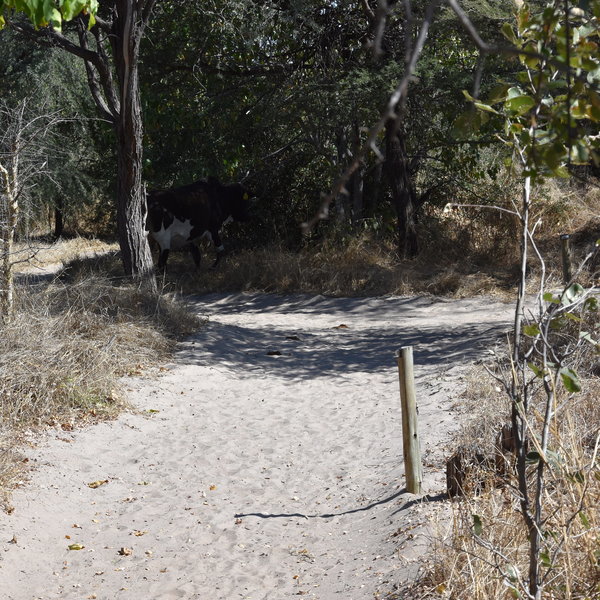
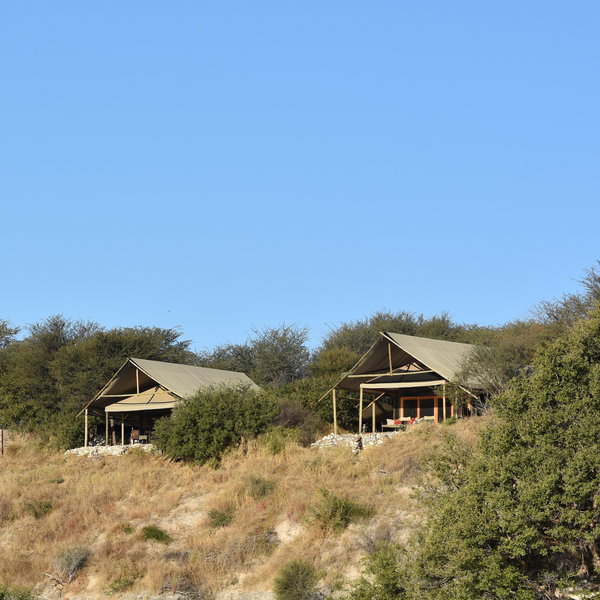
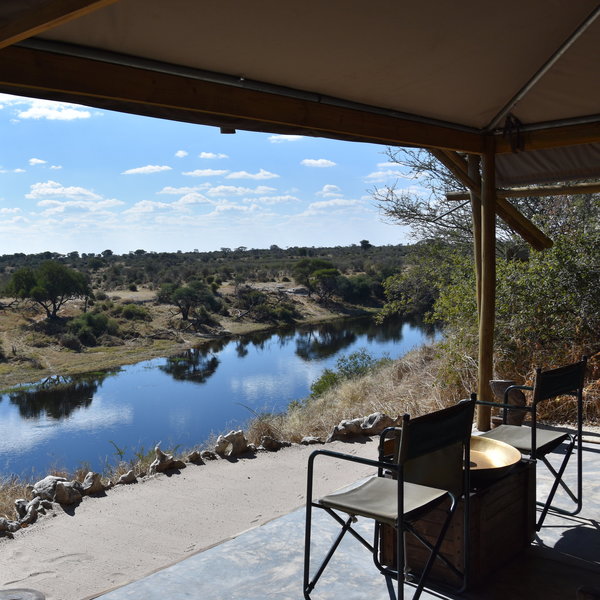
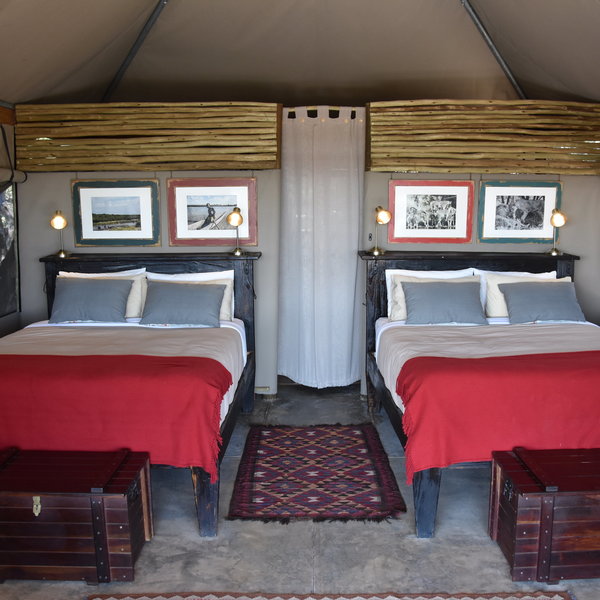
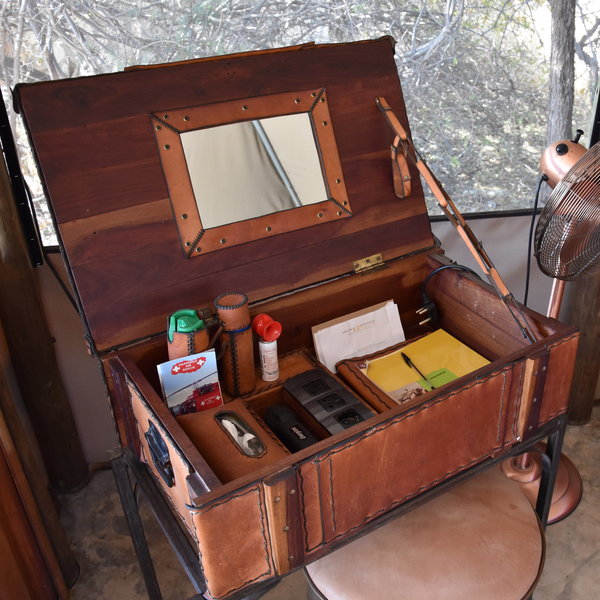
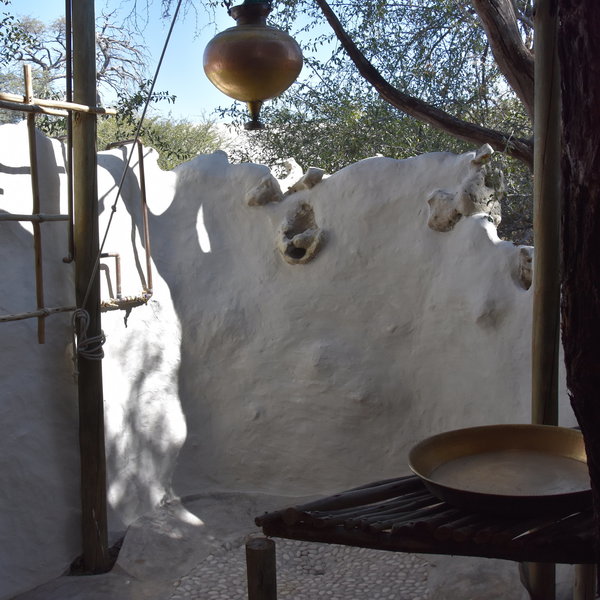
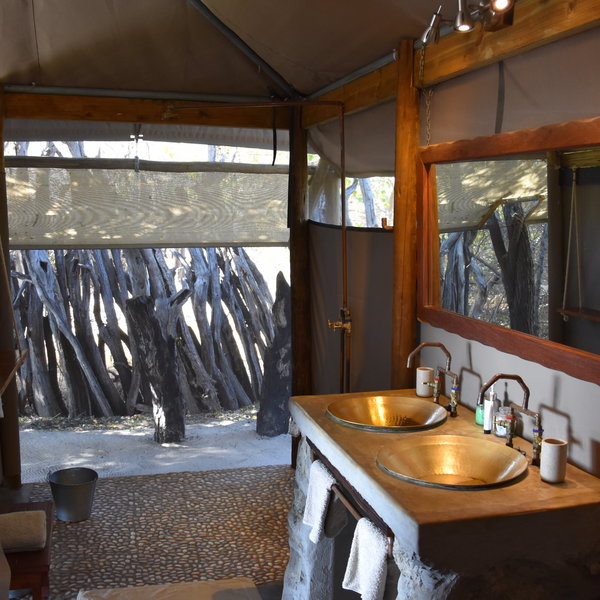
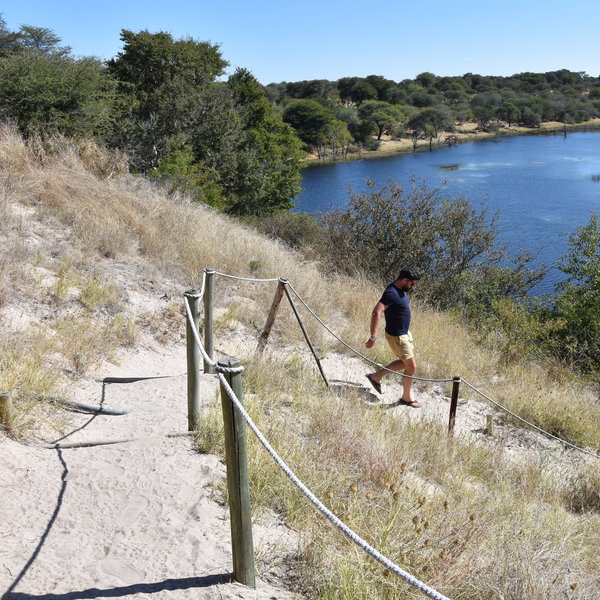
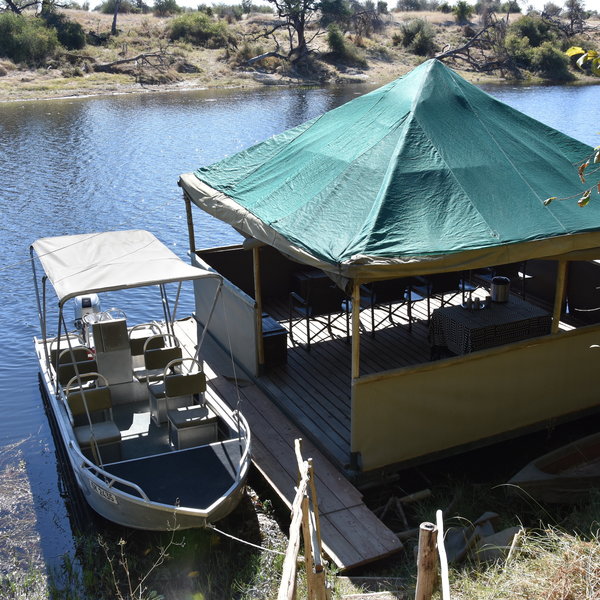
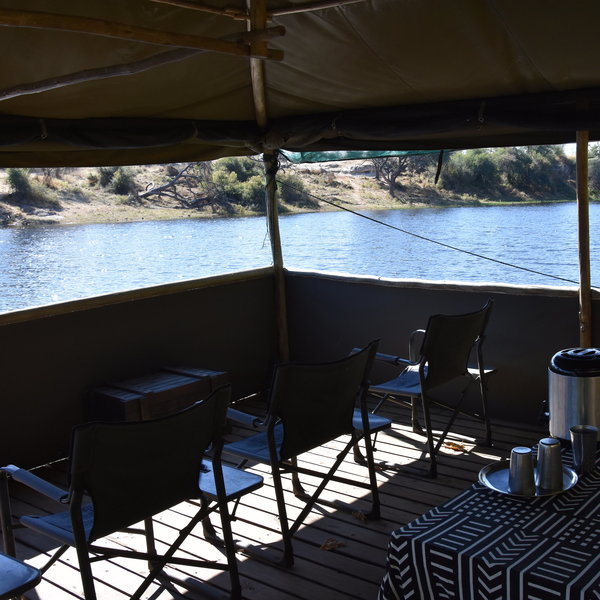
Expert Africa's gallery
When we travel we take lots of photos ourselves to give you a real and un-edited view of the safaris. See our 54 pictures and 1 videos of Meno A Kwena to get the candid view.
View galleryMeno A Kwena: Our full report
Meno A Kwena is an old-style safari camp; the owners we know well.
It is situated on tribal land on a cliff edge overlooking the Boteti River, which began to flow again in late 2008, having been dry for over 15 years. The name Meno A Kwena is the local name for the area, which translates as 'teeth of the crocodile'.
The transformation since the river began to flow again is remarkable. On our last visit, the late afternoon was a great time to see elephant and zebra coming down to drink on the opposite side of the river. Indeed, many visitors, especially in the dry season, choose to stay around the camp – enjoying the friendly atmosphere, the views and the wildlife. That said, the return of the river has changed the dynamic of the game in the area somewhat. Meno is no longer the hive of lion activity it once was and, whilst they can still be heard at night, lions now visit the camp only occasionally.
The tents at Meno A Kwena don't aim to be palatial – although royalty have been known to stay. The nine newly renovated meru tents are enclosed in individual kraals, all tents now have en suites connecting through the back of the tent
Sand paths through the bush link the tents to Meno A Kwena's main area. A large L-shaped marquee makes up the kitchen, bar, dining area and lounge, complete with well-stocked reference library and comfortable sofas scattered with cushions. The whole area – even the toilet – is filled with interesting skulls, bones, artefacts and photographs.
In front, a campfire and plunge pool built of rock overlook the Boteti River and onward into the Makgadikgadi Pans National Park. There are a couple of chill-out areas here, too, with comfortable sala beds and the odd hammock. During our last visit we were able to use the floating pontoon hide, this ideal for photography and game-viewing on the river.
Two bird baths near the main area are frequented by pied babblers, crimson breasted shrikes, buffalo weavers, red-billed francolins and the occasional goshawk.
Activities from Meno A Kwena include walking trips and cultural activities with the local community. Overnight trips into the Makgadikgai Salt Pans are available on request so please ask us if you're interested. T
4WD safaris are also available, varying from short sorties in the local Khumaga area to full-day safaris with a picnic further afield in Makgadikgadi Pans National Park or Nxai Pan National Park. Visitors should be aware that although Meno A Kwena lies on the edge of the Makgadikgadi Pans National Park, the pans themselves are actually a two–four-hour drive away, so those arriving and expecting the saltpans on the doorstep will be disappointed. With the river now flowing again, access to the national park is via a one-vehicle 'ferry'.
Activities
4WD Safari
Birdwatching
Boat trip
Cultural excursion
Guided walking safari
Private activities
Families & children
- Attitude towards children
- Children of all ages are welcome.
- Property’s age restrictions
- Children of all ages years are accepted but private vehicles must be booked for families with children under 12 years old.
- Special activities & services
- The guiding technique at Meno A Kwena involves touching, tasting, looking and discussing, which works well for children who are keen to learn about the environment. Children's meals can be requested.
- Generally recommended for children
- Although Meno A Kwena is a very relaxed camp, and the team very child-friendly, it does still get the odd visit from lion – which do, on occasions, walk along the footpaths and around the main kraals.
- Notes
- Meno A Kwena is not ideal for those who are looking solely for game drives to spot animals, but older children who are interested in taking part and learning about nature and the environment will love it.
Food & drink
- Usual board basis
- Full Board & Activities
- Food quality
- We have visited Meno A Kwena many times and have always found the food delicious and of a high standard; this is particularly impressive as it is all cooked over an open fire. Plenty of fresh ingredients are used together with well-made sauces and flavours.
Breakfast usually consists of cereals, fresh fire-baked bread, yoghurts, juice and your choice of eggs. The timing is very flexible, depending on the morning activities you have planned.
Lunch is usually served at 1pm and includes a main dish such as quiche, pie or lasagne with a choice of salads, finished off with bread and a selection of cheeses.
Dinners are three-course affairs that often begin with soup and end with a light and delicious dessert.
Just in case you get peckish between meals there is often a freshly baked cake for afternoon tea, and snacks to accompany your sundowner drinks. - Dining style
- Mixture of group dining and individual tables
- Dining locations
- Indoor and Outdoor Dining
- Further dining info, including room service
- No – food and drink not recommended in tents as the camp feels that they don't want to encourage any of the wildlife to enter the tents.
- Drinks included
- If booked on a full board basis then yes, except premium brands. Most spirits are available including vodka, whisky and gin. Beers, wine, water (bottled or filtered borehole water), soft drinks, tea, coffee, hot chocolate are readily available throughout the day.
Our travellers’ wildlife sightings from Meno A Kwena
Since mid-2018, many of our travellers who stayed at Meno A Kwena have kindly recorded their wildlife sightings and shared them with us. The results are below. Click an animal to see more, and here to see more on our methodology.

100% success

100% success

100% success

100% success

0% success

0% success

0% success

0% success

0% success

0% success

0% success

0% success

0% success

0% success

0% success
Getting there
- Location
- Kalahari's Salt Pans, Botswana
- Ideal length of stay
- We'd recommend Meno A Kwena for a couple of nights for first time visitor's to Botswana, perhaps longer if you are a regular to Botswana and want something more than just the big game experience. We think it works particularly well at the beginning of a trip, when it offers a chance to relax after a long flight.
- Directions
- Road transfers from Maun to Meno A Kwena take about 1½ hours and are included in the camp's accommodation rate. Alternatively, there is an airstrip 17km from camp at Motopi, with a 20-minute transfer to camp available.
- Accessible by
- Self-drive or Fly-and-Transfer
Special interests
- Photography safaris
- Standing high above the Boteti River, Meno A Kwena has a cool and well-situated hide which makes a good spot for keen photographers to take unobtrusive pictures of busy wildlife scenes.
- See ideas for Photography safaris in Botswana
Communications
- Power supply notes
- Solar and charging socket’s available
- Communications
- The camp has a VSat landline for their own use and in case of emergencies. Slight mobile reception is available as well as Wifi.
- TV & radio
- No.
- Water supply
- Borehole
- Water supply notes
- Water is not suitable for drinking.
Health & safety
- Malarial protection recommended
- Yes
- Medical care
- The camp has a full first aid kit available and the guides have had first aid training.
Vehicle transfers to Maun hospital for relatively serious incidents. The Medivac helicopter in Maun is always on standby for emergencies. Please note that it is only possible to fly out of camp during daylight hours as the bush airstrips do not have any lighting at night. - Dangerous animals
- High Risk
- Security measures
- Guests are escorted to and from their tents after dark.
To one side of the camp is the Boteti River overlooking the Makgadikgadi Pans National Park. The rest of the camp is surrounded by an electric fence. There are no safes, so guests are advised to keep valuables on them. Staff are always around during the day time but there are no security guards. - Fire safety
- The camp is fitted with fire extinguishers which are checked every 12 months.
Useful info
- Disabled access
- Not Possible
- Laundry facilities
- Included – collected in morning and returned the same day. A laundry bag is available in tents.
- Money
- There is no currency exchange at Meno A Kwena.
Plan and book your trip with Expert Africa
All of our trips are tailor-made, so we'll always adapt them to suit you. Talk to an Expert and let us plan and arrange your perfect trip.

Talk to an Expert
Call or email us now! We’ll match you with the Specialist in our team who is best suited to help you. Then together we can start planning your trip.

Set up your itinerary
Based on our experience and your ideas, your specialist will create a detailed, costed itinerary. We’ll refine it together, until we have a trip that you’re perfectly happy with.

Prepare for your trip
The same Specialist will make the seamless arrangements for your trip, send you detailed travel documents, and be available to answer any questions before you depart.

Travel with peace of mind
After you set off, you’ll be cared for by our partners in Africa, most of whom have worked with Expert Africa for decades. And if you ever need us urgently, we’re available 24/7.

When you return
We love to learn about your trip, and so will always be grateful if you’ve the time to give feedback to your Specialist when you return.
Meno A Kwena's location
Look closer at the environment and surroundings of Meno A Kwena.
Excursions from Meno A Kwena
Optional extra day-trips and excursions possible whilst you're staying at Meno A Kwena. Talk to us: these are usually best arranged before you go.
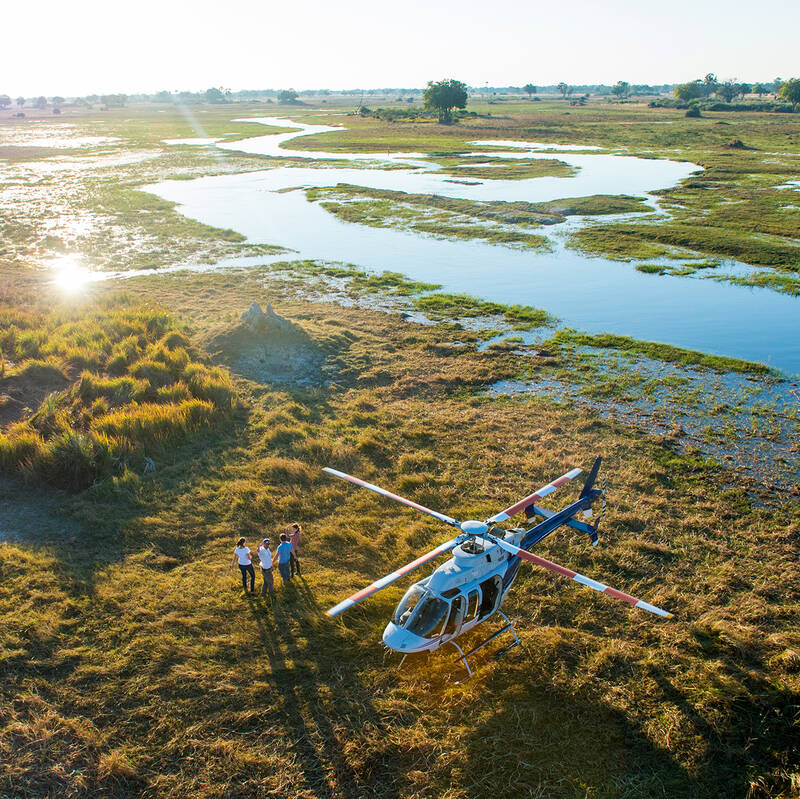
Helicopter Flight - Botswana
Various: from 30 minutes to half a day.
Low-flying, agile and offering superb views, helicopters are an ideal way to move around the Okavango Delta.You can use them instead of fixed-wing inter-lodge transfers or as an addition to other wildlife watching activities, and of course, helicopters can hover to allow that perfect pic, whereas fixed-wings can’t.
More about Helicopter FlightOther lodges in Kalahari's Salt Pans
Alternative places to stay in this same area.
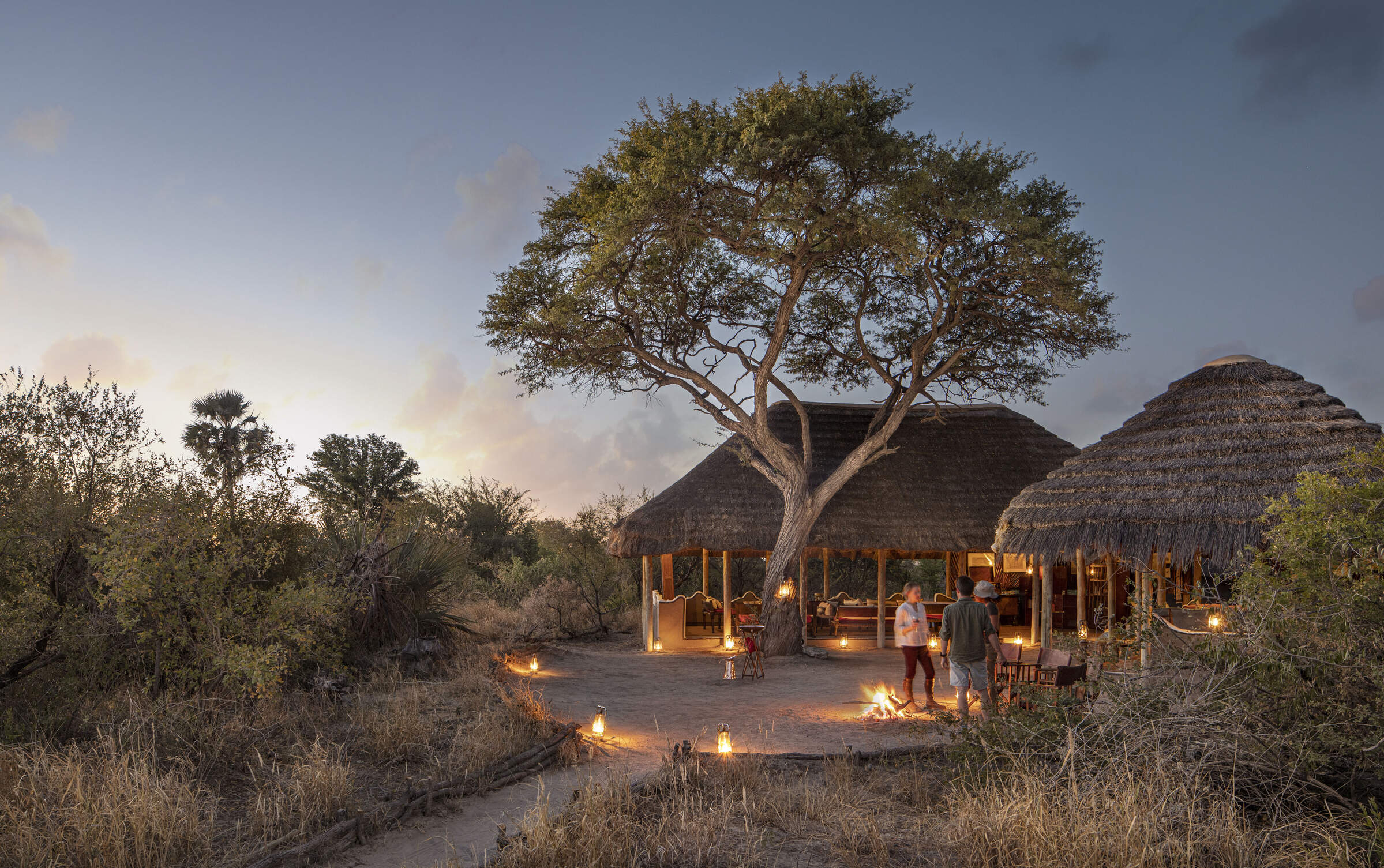
Camp Kalahari
Overlooking the Makgadikgadi Pans, Camp Kalahari is great value; come for quadbiking excursions on the salt pans, cute meerkats, excellent Bushman walks, and interesting 4WD safaris.
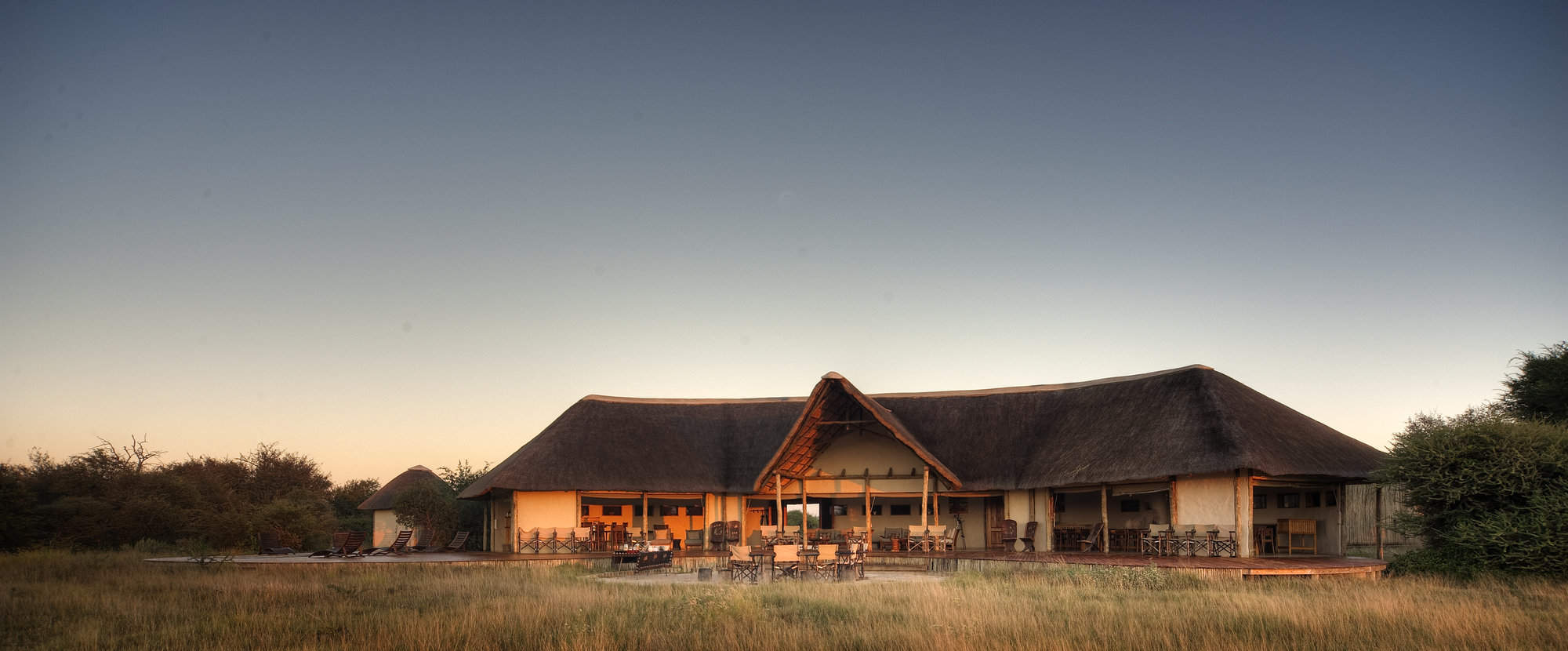
Nxai Pan Camp
Offering good summer game viewing and visits to Baines Baobabs, the comfortable Nxai Pan Camp is currently the only permanent camp in Nxai Pan National Park.
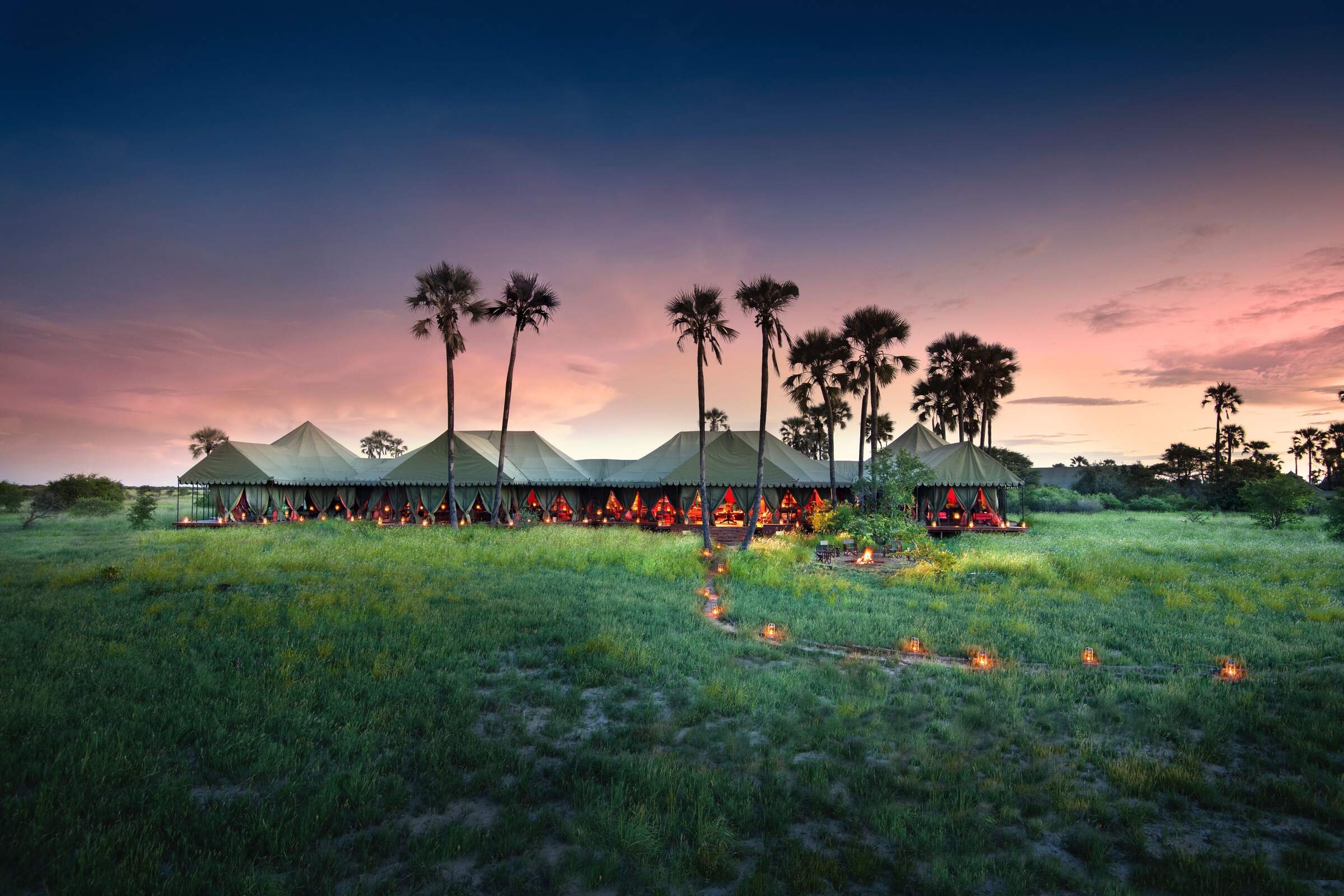
Jack's Camp
Jack's Camp was the original camp in the Makgadikgadi area, and many still consider it the best. Come for a unique and memorable experience, but not for prolific game viewing.
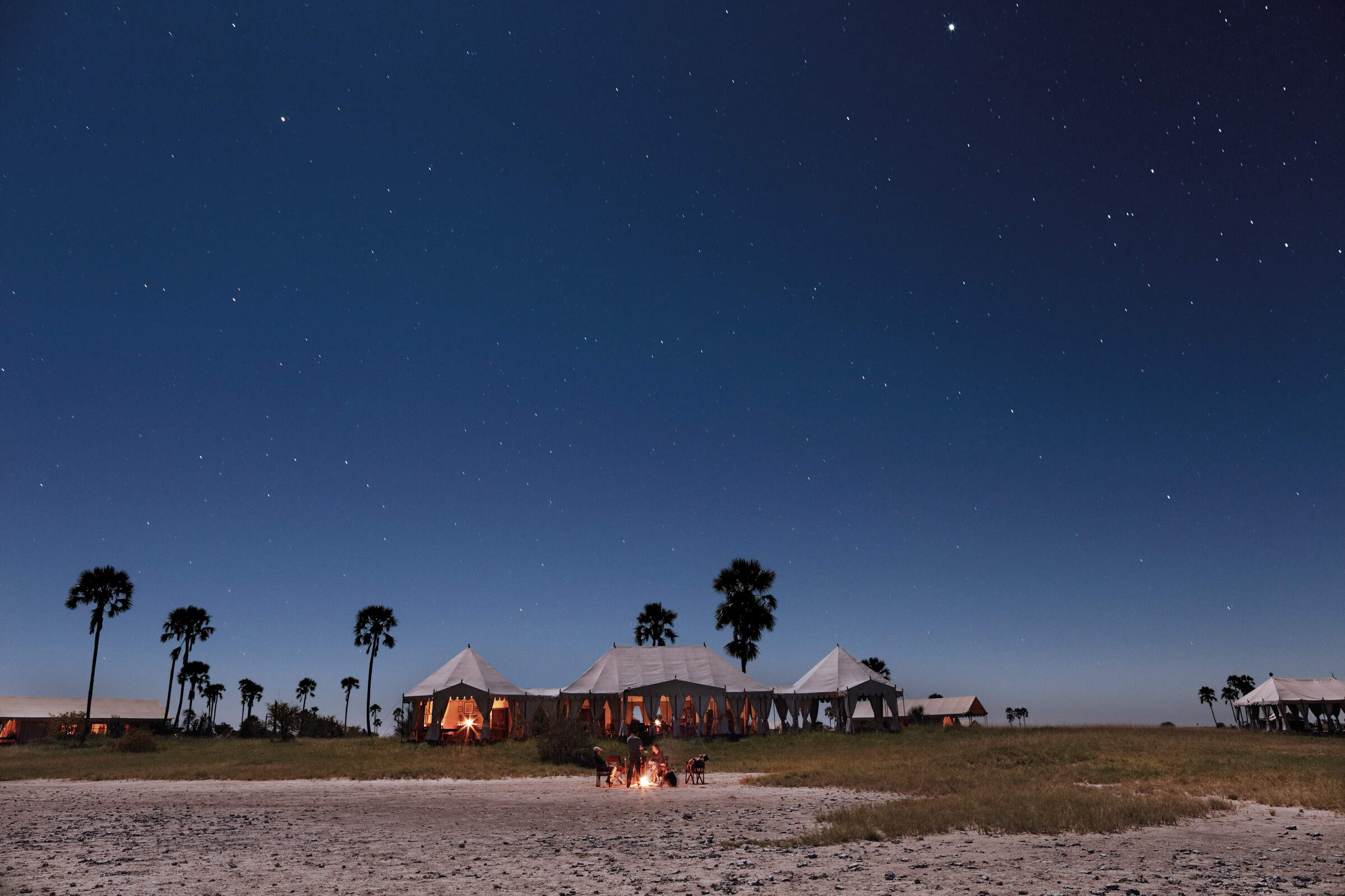
San Camp
The simple but stylish San Camp lies in a stunning location beside the Makgadikgadi Salt Pans, where highlights are quadbiking, meerkats, and Bushmen walks.
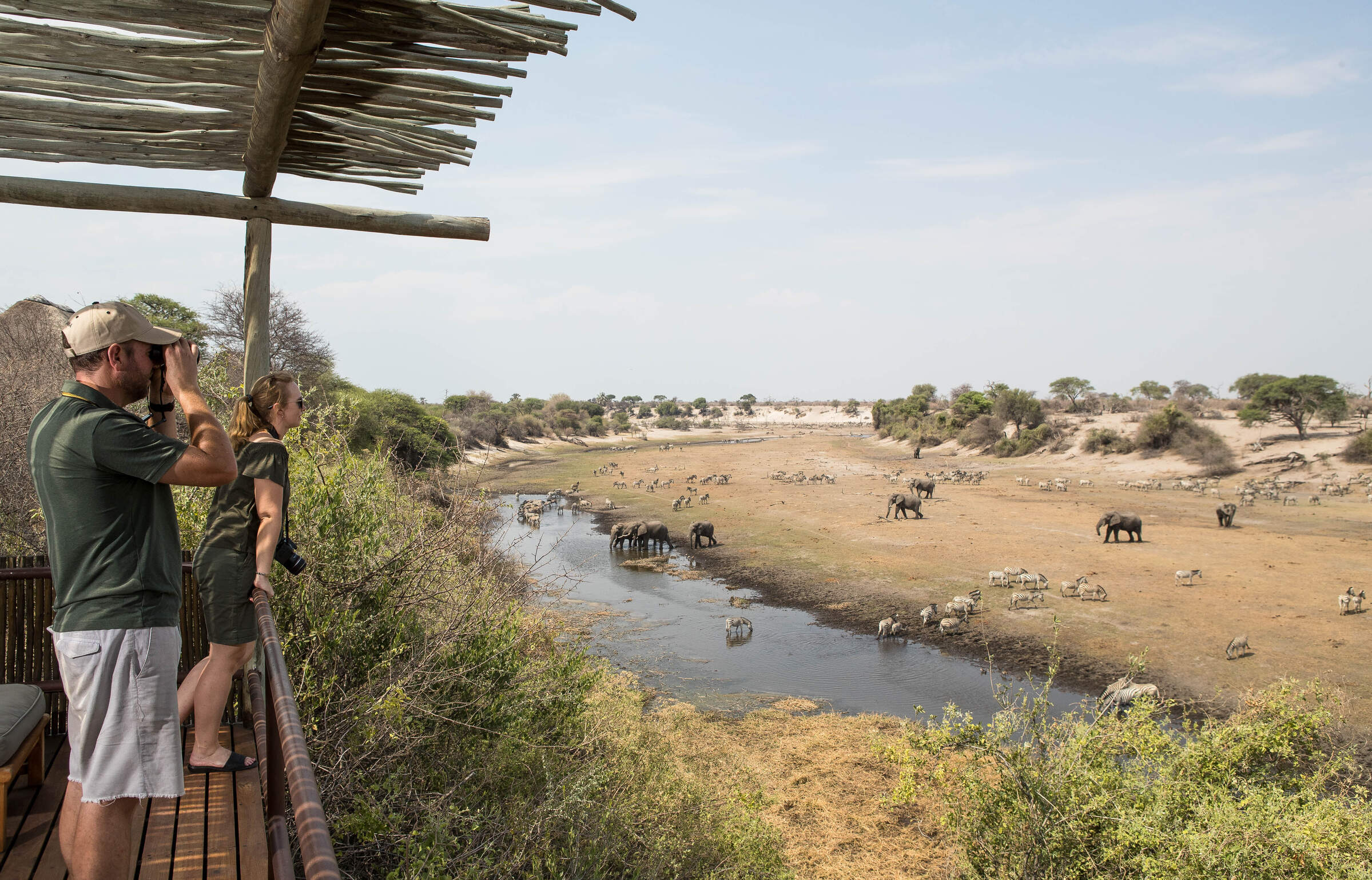
Leroo La Tau
From the western bank of the Boteti River, Leroo La Tau overlooks the Makgadikgadi Pans National Park, where game concentrations are highest from July to October.
When to go to Kalahari's Salt Pans
Our month by month guide: What it's like to visit Meno A Kwena in Kalahari's Salt Pans
Jan
Feb
Mar
Apr
May
Jun
Jul
Aug
Sep
Oct
Nov
Dec
Kalahari's Salt Pans in January
January is the peak of the rainy season, bringing short but intense downpours that flood the pans, transforming the landscape into a lush paradise. The Makgadikgadi and Nxai pans become vast grasslands, attracting large herds of zebra and wildebeest as part of their annual migration. The Boteti River swells, supporting a diversity of wildlife.
Birdwatching is exceptional, with migratory birds and flamingos breeding in Sua Pan. While game viewing can be challenging due to dispersed wildlife, patient observers can spot predators like lions and cheetahs taking advantage of newborn prey.
Low-season rates make this an attractive time for budget-conscious travellers.
- Salt pans flood, creating a dramatic transformation
- Zebra migration draws predators
- Flamingo breeding season in Sua Pan
- Exceptional birdwatching and photography opportunities
- Low visitor numbers, offering an exclusive experience
Our view
A good time to visit, with pros & cons
Weather in January
Kalahari's Salt Pans in February
February remains lush and vibrant, with the zebra migration in full swing across the pans. Nxai Pan National Park is particularly rewarding, as grasslands attract large herbivore herds and their predators. The famous Baines’ Baobabs stand starkly against the green backdrop, making for breathtaking photography.
With water sources abundant, birdwatching is at its peak, and flamingos continue to thrive in Sua Pan. The Boteti River remains active, drawing thirsty wildlife. However, thick vegetation can make spotting large animals more challenging.
Camps and lodges offer excellent availability and value during this period.
- Peak of the rainy season, pans fully flooded
- Zebra migration at its most dramatic
- Flamingos still abundant in Sua Pan
- Green season rates offer excellent value
- Lush landscapes provide an ideal setting for photography
Our view
A good time to visit, with pros & cons
Weather in February
Kalahari's Salt Pans in March
March is a transitional month: the main rains beginning to taper off but the Makgadikgadi and Nxai Pan landscapes remain lush and teeming with life. The zebra migration starts moving northward from Makgadikgadi and Nxai, but large herds are still present, making this a great time for game viewing.
If it’s accessible, this is a lovely time to visit Kubu Island, as the contrast between the granite outcrops and the surrounding greenery can be striking. Predators remain highly active, particularly around Nxai Pan and Kukome Island, where they hunt the last of the young antelope. Birdwatching is still rewarding, and as water begins to recede, quad biking opportunities start opening up in drier areas.
- Rains begin to taper off, but pans remain lush
- Final opportunity to witness the zebra migration
- Flamingos start to disperse from Sua Pan
- Good predator-prey interactions
- Shoulder season begins, with fewer tourists
Our view
A good time to visit, with pros & cons
Weather in March
Kalahari's Salt Pans in April
While occasional late rains may occur, April marks the end of the rainy season, with floodwaters receding and the landscape drying out. The Makgadikgadi Pans begin transitioning back to their iconic white salt flats as the water evaporates, creating striking contrasts for photography. This creates a unique landscape where wildlife is easier to spot against the increasingly barren backdrop.
Wildlife concentrates around the remaining waterholes in Nxai Pan, while the Boteti River can becomes a valuable lifeline for thirsty animals. Walks with San Bushmen and quad biking adventures on the salt pans become more accessible.
Night-time temperatures begin to drop, especially in the Central Kalahari area, making for comfortable evening game drives to spot nocturnal animals.
- Floodwaters recede, exposing salt flats
- Wildlife concentrates around remaining water
- Clear skies and mild temperatures perfect for game drives
- Baines’ Baobabs surrounded by seasonal water, ideal for photography
- Last month for good green season game viewing
Our view
A good time to visit, with pros & cons
Weather in April
Kalahari's Salt Pans in May
May is a popular month to visit the Kalahari Salt Pans region. The landscape has transformed, with the vast white expanses of Makgadikgadi Pans becoming more prominent. This creates surreal, otherworldly vistas perfect for photography. Wildlife concentrates around permanent water sources like the Boteti River, offering excellent game viewing opportunities. In Nxai Pan National Park, the famous Baines Baobabs stand out starkly against the drying landscape.
This is an ideal time for quad biking adventures across the salt pans. Cooler temperatures, especially in the mornings and evenings, lead to increased predator activity, and meerkat interactions are particularly rewarding, as they are active in the open plains. The skies remain crystal-clear, making for spectacular stargazing and astrophotography.
- Salt flats dry out, creating surreal landscapes
- Wildlife gathers at permanent water sources
- Perfect temperatures for safaris
- Quad biking becomes widely available
- Meerkat encounters highly rewarding
Our view
A very good time to visit
Weather in May
Kalahari's Salt Pans in June
June marks the official start of the dry season in the Kalahari Salt Pans region, bringing crisp, cool mornings and clear skies. The Makgadikgadi and Nxai pans are now vast, shimmering white expanses, offering incredible photographic opportunities. Wildlife viewing is excellent as animals congregate around the Boteti River.
Night-time temperatures can reach freezing, but daytime temperatures are pleasant. The clear, crisp air enhances visibility, making this a favourite time for serious photographers and one of the best months for stargazing. The atmosphere in June is at its clearest, allowing for spectacular views of the Milky Way. Meerkat encounters continue to be a highlight, with the animals more active in the cooler weather. The salt pans are now bone-dry, opening up thrilling quad biking excursions.
- Cold mornings, comfortable days for safaris
- Wildlife highly visible along the river and scarce waterholes
- Best time for quad biking across the salt pans
- Exceptional stargazing with crystal-clear skies
- Meerkats remain highly active and visible
Our view
Fantastic: the very best time to visit
Weather in June
Kalahari's Salt Pans in July
July offers excellent conditions for exploring the Kalahari Salt Pans. The Makgadikgadi Pans present a stark, lunar-like landscape, perfect for atmospheric photography. Wildlife viewing is superb, with animals concentrated around permanent water sources like the Boteti River. This is an excellent time to visit Nxai Pan National Park, where the famous Baines Baobabs stand out dramatically against the dry landscape.
The clear night skies offer phenomenal stargazing opportunities. Quad biking adventures across the salt pans are popular, providing a thrilling way to experience the vast, otherworldly terrain. Meerkat encounters continue to be a highlight, with these charismatic animals easily observable in the sparse vegetation. Guided walks with San Bushmen offer insights into traditional survival skills in this harsh environment.
- Peak dry season, best time for game viewing
- Ideal conditions for astrophotography
- Wildlife highly concentrated around water sources
- Quad biking across vast salt flats remains a highlight
- Bushmen cultural experiences highly recommended
Our view
Fantastic: the very best time to visit
Weather in July
Kalahari's Salt Pans in August
August marks the height of the dry season and is a popular time to visit the Kalahari Salt Pans, coinciding with northern hemisphere summer holidays. Mornings are cool and days are warm, making it perfect for a range of activities.
The Makgadikgadi and Nxai pans are at their driest, offering surreal, moon-like landscapes. Wildlife viewing is excellent, with animals congregating around the few remaining water sources, particularly along the Boteti River. This is a good time for exciting quad-biking adventures across the vast salt pans – though nights are cold.
For something more sedate, meerkat encounters continue to be a highlight, with clear visibility in the sparse vegetation, and evening stargazing is spectacular due to cloudless skies. The contrast between the white salt pans and the silhouettes of Baines Baobabs in Nxai Pan make for stunning photographic opportunities.
- Peak dry season, animals concentrated at the Boteti River
- Quad biking and guided walking safaris are at their best
- Clear night skies offer stunning stargazing conditions
- Wildlife sightings include elephants, lions, and plains game
- Meerkat encounters continue to be excellent
Our view
Fantastic: the very best time to visit
Weather in August
Kalahari's Salt Pans in September
September brings rising daytime temperatures to the Kalahari Salt Pans, while nights remain cool. The landscape is at its driest, with Makgadikgadi and Nxai pans offering vast, shimmering expanses. This creates ideal conditions for quad biking adventures and stunning photography, especially during the golden hours.
Wildlife activity remains high around permanent water sources, and the dry conditions make it easier to spot predators, particularly around the Boteti River and remaining waterholes. Nxai Pan National Park offers great opportunities to see desert-adapted species. This is a prime time for meerkat encounters, as these charismatic creatures are highly active. San Bushmen cultural experiences are particularly insightful at this time, as they demonstrate survival techniques in one of the driest landscapes of the year.
- Excellent predator viewing as dry conditions continue
- Elephants and large herbivores still frequent waterholes
- Sunsets are especially dramatic due to dust in the air
- Prime month for San Bushmen-guided experiences
- Stargazing and astrophotography remain outstanding
Our view
Fantastic: the very best time to visit
Weather in September
Kalahari's Salt Pans in October
October is one of the hottest and driest months in the Kalahari Salt Pans region, with daytime temperatures often exceeding 40°C/104°F. The Makgadikgadi and Nxai pans are vast, shimmering expanses, creating surreal, mirage-like vistas. This marks the last peak of wildlife concentration at the few remaining water sources before the first rains arrive. Predator-prey interactions along the Boteti River can become particularly dramatic.
Quad biking across the salt pans offers exhilarating adventures and unparalleled views of the lunar-like landscape. Meerkat encounters continue to be a highlight, with clear visibility in the sparse vegetation. As the month progresses, the chances of seeing dramatic dust storms increases, creating otherworldly scenes on the dry pans. The extreme conditions showcase the remarkable adaptations of desert wildlife. Stargazing is exceptional due to very clear skies.
- Hottest and driest month of the year
- Wildlife congregates along river and shrinking water sources
- Predator activity at its peak due to prey vulnerability
- Dramatic sunsets and striking landscape photography
- Quad biking and walking safaris continue to be a highlight
Our view
Fantastic: the very best time to visit
Weather in October
Kalahari's Salt Pans in November
November signals the start of the rainy season, with occasional early showers rejuvenating the arid landscape of the Makgadikgadi and Nxai pans. These rains are often short but heavy, creating spectacular storm clouds and lightning shows. The parched earth quickly absorbs the moisture, and the first flush of green begins to appear. Zebra herds begin returning to the salt pans, following the first shoots of fresh growth.
As water sources become more available, wildlife disperses slightly, but this is still an excellent time to visit. The mix of dry and wet conditions creates a striking contrast for photographers, and birdwatching improves as migratory species return.
- First signs of the wet season with sporadic rain showers
- Early zebra herds return to the pans
- Birdwatching season begins with new arrivals
- Beautiful contrasts between dry and green landscapes
- Shoulder season rates offer good value
Our view
A good time to visit, with pros & cons
Weather in November
Kalahari's Salt Pans in December
The rains in Botswana have now started, bringing some respite to the high temperatures. Game viewing becomes harder as wildlife is more dispersed but great sightings can still be had in the right areas such as Khwai and the Kwara and Mombo concessions.
Areas such as the Makgadikgadi Pans change completely with the salt pans becoming covered in a shallow layer of water attracting large numbers of breeding flamingos. Low-season rates at many camps are a draw.
- Temperatures starting to fall from the highs of October/November
- Very high chance of rain, usually large heavy storms for short periods
- Flamingos return to breed at the Makgadikgadi Pans
- Wildlife more dispersed, so game viewing more challenging
- Typically low-season rates in the camps
Our view
A good time to visit, with pros & cons
Weather in December

Looking for inspiration on where to travel next?
Visit our trip chooser to explore your options and find inspiration for your perfect African adventure
Inspire me